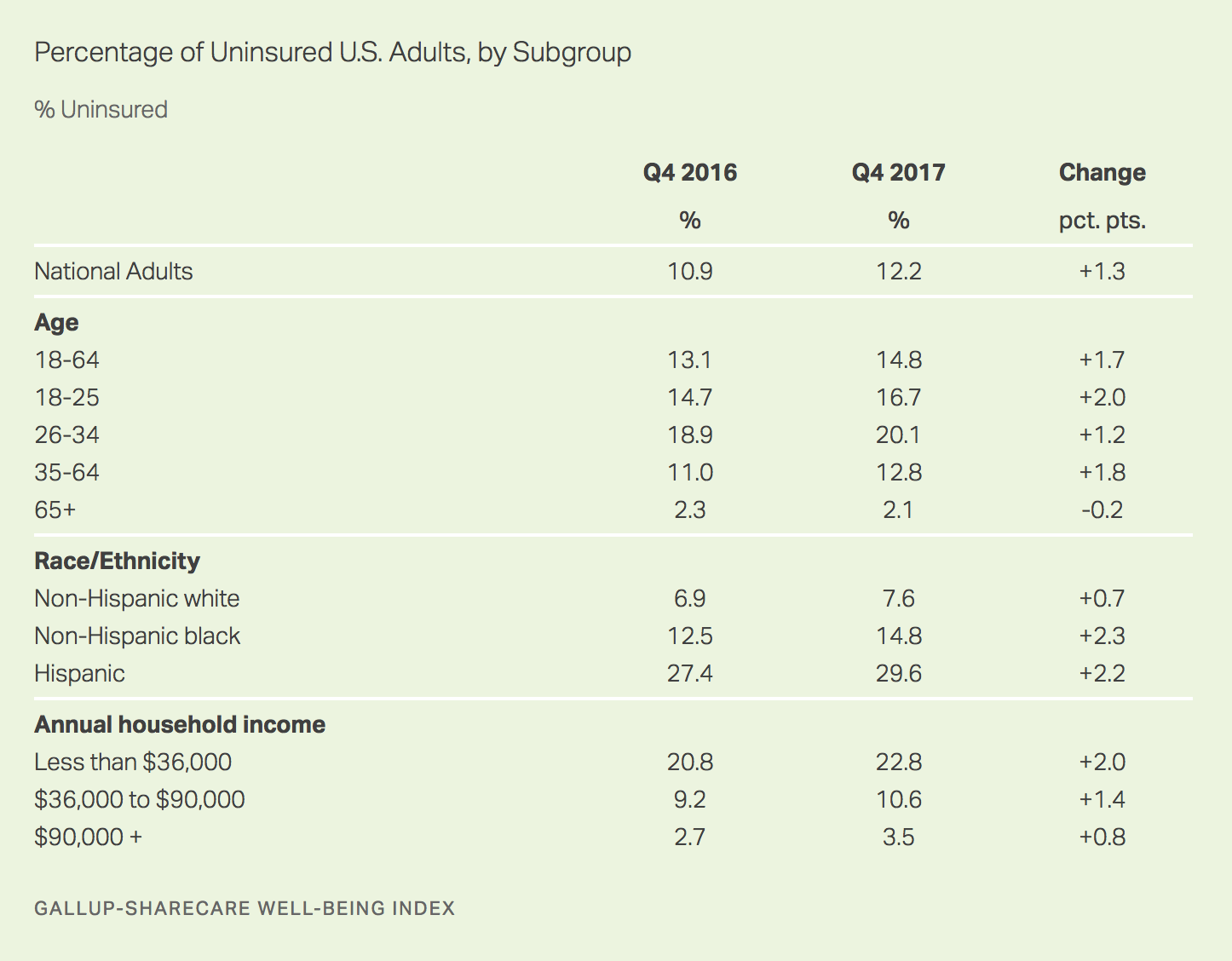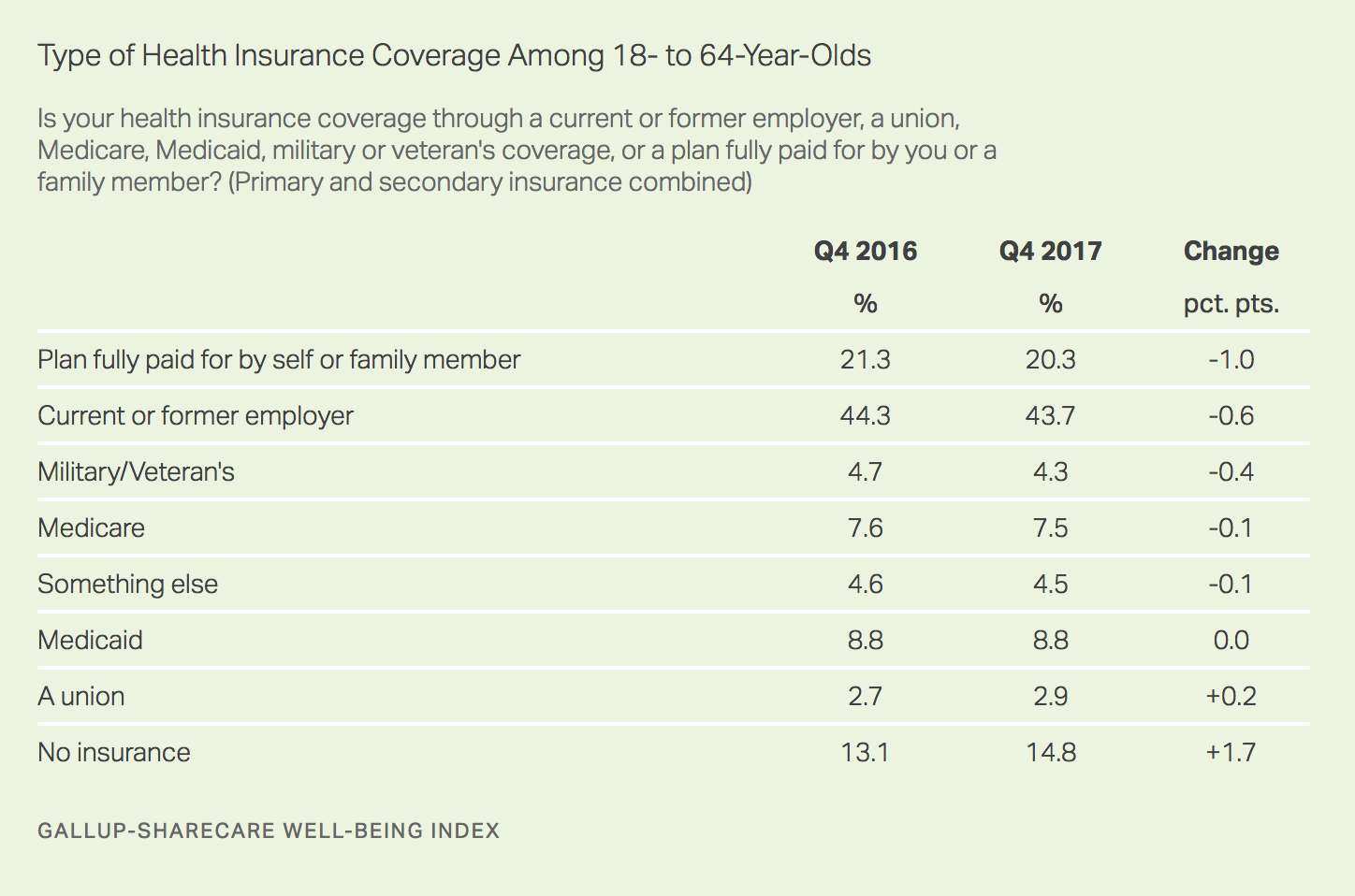U.S. Uninsured Rate Steady at 12.2% in Fourth Quarter of 2017
STORY HIGHLIGHTS
- Uninsured rate essentially unchanged from 12.3% in third quarter of 2017
- Uninsured rate has increased 1.3 points since last quarter of 2016
WASHINGTON, D.C. — The percentage of U.S. adults without health insurance was essentially unchanged in the fourth quarter of 2017, at 12.2%, but it is up 1.3 percentage points from the record low of 10.9% found in the last quarter of 2016. The 1.3-point increase in the uninsured rate during 2017 is the largest single-year increase Gallup and Sharecare have measured since beginning to track the rate in 2008, including the period before the Affordable Care Act (ACA) went into effect. That 1.3 point increase represents an estimated 3.2 million Americans who entered the ranks of the uninsured in 2017.

The results for the fourth quarter of 2017 are based on more than 25,000 interviews with U.S. adults aged 18 and older from October 1 to December 31, conducted as part of the Gallup-Sharecare Well-Being Index.
Despite the uninsured rate rising in 2017, it remains well below its peak of 18.0% measured in the third quarter of 2013, prior to the implementation of the ACA’s healthcare exchanges and the requirement that most adults have health insurance or be subject to a fine, commonly known as the individual mandate.
Several factors likely contributed to the increase in the uninsured rate in 2017. Some insurance companies stopped offering insurance through the exchanges, and the resulting lack of competition drove up the cost of plans for consumers. This may have caused some Americans, especially those who failed to qualify for federal subsidies, to forgo insurance.
Further, media coverage of the policies to repeal and replace the healthcare law may have caused some consumers to question whether the government would enforce the penalty for not having insurance. Congressional Republicans made several attempts to repeal or replace the healthcare law during 2017, ultimately passing a tax bill in December that repealed the individual mandate.
Uninsured Rate Up Among Key Subgroups
The uninsured rate rose for all demographic groups in 2017, with the exception of those aged 65 and older, all of whom qualify for Medicare coverage. It increased most among young adults, blacks, Hispanics and low-income Americans.
Importantly, the uninsured rate among adults aged 18-25 rose by 2.0 points in 2017. Young adults serve a critical function in healthcare markets because their low usage of healthcare helps offset the higher costs of insuring older Americans.
Black and Hispanic adults saw a 2.3 and 2.2 point increase in their uninsured rate in 2017, respectively. By comparison, the uninsured rate for whites grew less than 1.0 point over that same period. The percentage of low-income adults without health insurance in 2017 rose 2.0 points, while middle- and high-income Americans’ saw their uninsured rates increase by 1.4 and 0.8 points, respectively.
Fewer Americans Bought Their Own Health Plans in 2017
Gallup and Sharecare also track the ways in which Americans aged 18 to 64 (those who are not eligible for Medicare) obtain their health insurance — whether that be through an employer, union, the government or a direct purchase from an insurance company.
By far, the biggest change in 2017 was the decline in the percentage of Americans purchasing their own plans, likely through ACA healthcare exchanges. In the last quarter of 2017, 20.3% of Americans said they bought their plan themselves, down 1.0 point from 21.3% at the end of 2016.
This decline in the percentage of Americans who pay for their own coverage marks a reversal of the trend seen since the ACA’s individual mandate took effect in the third quarter of 2013. Between then and 2016, the percentage of adults with coverage via self-paid plans had grown 3.7 points.
Other sources of health insurance remained largely unchanged in 2017, with the second-largest difference being a 0.6 point decrease in those receiving coverage through an employer.
Gallup and Sharecare began asking Americans about the source of their health insurance using the current question wording in August 2013 in anticipation of shifts in how people would receive their health insurance after the healthcare exchanges opened. Gallup asks Americans, “Is your primary health insurance coverage through a current or former employer, a union, Medicare, Medicaid, military or veteran’s coverage, or a plan fully paid for by you or a family member?” Gallup also asks respondents whether they have secondary health insurance coverage and, if so, what type of coverage it is. These results reflect those combined responses of primary and secondary insurance types.
Implications
From 2014 to 2016, the uninsured rate fell consistently. However, that trend reversed last year. During 2017, the Trump administration reduced the advertising budget that promoted sign-ups on the ACA exchanges by 90% and also cut the signup period for the healthcare exchanges in half. Despite these changes, nearly as many people signed up for health insurance on the ACA exchanges for 2018 as did for 2017.
However, it seems likely that the uninsured rate will rise further in the years ahead. President Donald Trump signed a tax bill into law in December that included a repeal of the individual mandate. Without this requirement to have health insurance, it is likely that some Americans will drop their coverage. Rising insurance premiums, which are expected to continue to increase, could also result in some Americans forgoing health coverage. Young adults will be most likely to go without health coverage, meaning that they will no longer help offset the costs of older, less healthy adults — which will drive up premiums even more.
Having passed their tax bill, congressional Republicans’ 2018 legislative goals include reforming funding mechanisms for Medicaid and Medicare — programs that subsidize healthcare coverage for low-income, disabled and elderly Americans. With less federal assistance from these programs to help offset the rising cost of health insurance, fewer Americans may be able to afford health insurance.
SURVEY METHODS
Results are based on telephone interviews conducted October 1-Dec. 31, 2017, as part of the Gallup-Sharecare Well-Being Index, with a random sample of 25,072 adults, aged 18 and older, living in all 50 U.S. states and the District of Columbia. For results based on the total sample of national adults, the margin of sampling error is ±0.4 percentage points at the 95% confidence level. All reported margins of sampling error include computed design effects for weighting.
Each sample of national adults includes a minimum quota of 70% cellphone respondents and 30% landline respondents, with additional minimum quotas by time zone within region. Landline and cellular telephone numbers are selected using random-digit-dial methods.
Learn more about how the Gallup-Sharecare Well-Being Index works.

